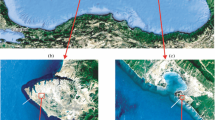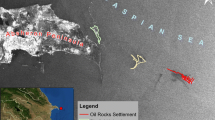Abstract
Accidental release of crude oil into the sea due to human activity causes water pollution and heavy damages to natural ecosystems killing birds, fish, mammals and other organisms. A number of monitoring systems are used for tracking the spills and their effects on the marine environment, as well as for collecting data for feeding models. Among them, Earth observation technologies play a crucial role and moderate spatial resolution satellite systems are able to collect images with a very short revisit time or even daily. This paper describes the use of Moderate-Resolution Imaging Spectroradiometer data for monitoring large oil slicks with the fluorescence/emissivity index and object-based image analysis. Two case studies are presented: the Deepwater Horizon (2010) and the Campos Basin (2011) oil spill accidents. Results show that it is possible to track the dynamics of the slick both for massive and long-lasting accidents and for smaller and very quick accidents. The main advantages of the method proposed are a straightforward implementation, a fast and semi-automated data processing and the capability of integration of daytime and nighttime acquisitions, as well as its adaptability to different sensors.












Similar content being viewed by others
References
Al-Hinai KG, Khan MA, Dabbagh AE, Bader TA (1993) Analysis of Landsat Thematic Mapper data for mapping oil slick concentrations—Arabian Gulf oil spill 1991. Arab J Sci Eng 18(2):85–93
Bentz C, de Miranda FP (2001) Application of remote sensing data for oil spill monitoring in the Guanabara Bay. Proc IGARSS01 Rio de Janeiro Brazil 1:333–335. doi:10.1109/IGARSS.2001.976149
Brekke C, Solberg AHS (2005) Oil spill detection by satellite remote sensing. Remote Sens Environ 95(1):1–13. doi:10.1016/j.rse.2004.11.015
British Petroleum (2010) Gulf of Mexico restoration—containing the leak. http://www.bp.com/sectiongenericarticle800.do?categoryId=9036583&contentId=7067603
Brivio PA, Lechi G, Zilioli E (2006) Principi e metodi di Telerilevamento. Città Studi—De Agostini, Milano
Casciello D, Lacavat T, Pergolat N, Tramutoli V (2007) Robust satellite techniques (RST) for oil spill detection and monitoring. Proceedings of 4th international workshop on the analysis of multitemporal remote sens images pp 1–6. doi:10.1109/MULTITEMP.2007.4293040
Clark RN, Curchin JM, Hoefen TM, Swayze GA (2009) Reflectance spectroscopy of organic compounds: 1. Alkanes. J Geophys Res Planets 114(E3):E03001. doi:10.1029/2008JE003150
Clark RN, Swayze GA, Leifer I, Livo KE, Kokaly R, Hoefen T, Lundeen S, Eastwood M, Green RO, Pearson N, Sarture C, McCubbin I, Roberts D, Bradley E, Steele D, Ryan T, Dominguez R, the Air borne Visible/Infrared Imaging Spectrometer (AVIRIS) Team (2010) A method for quantitative mapping of thick oil spills using imaging spectroscopy. U.S. Geol Surv Open-File Report 2010–1167
Dessì F, Melis MT, Naitza L, Marini A (2008) MODIS data processing for coastal and marine environment monitoring: a study on anomaly detection and evolution in Gulf of Cagliari (Sardinia, Italy). Int Arch Photogramm Remote Sens Spat Inf Sci XXXVII(B8), Beijing (China):695–698
Espedal HA (1999) Satellite SAR oil spill detection using wind history information. Int J Remote Sens 20(1):49–65. doi:10.1080/014311699213596
Espedal HA, Johannessen OM (2000) Detection of oil spills near offshore installation using synthetic aperture radar. Int J Remote Sens 21(11):2141–2144. doi:10.1080/01431160050029468
Energy-pedia news 27 Feb 2012 (2012) Brazil: Statoil announces new Brazilian pre-salt oil discovery in Campos Basin Block BM-C-33. http://www.energy-pedia.com/news/brazil/new-149305
Fingas M (2001) The basics of oil spill cleanup. CRC Press LLC, Boca Raton (Florida)
Fingas MF, Brown CE (1997a) Remote sensing of oil spills. Sea Technol 38:37–46
Fingas MF, Brown CE (1997b) Review of oil spill remote sensing. Spill Sci Technol Bull 4:199–208. doi:10.1016/S1353-2561(98)00023-1
Fingas MF, Brown CE (2011) Oil spill remote sensing: a review. Oil Spill Sci Technol 6:111–147
Fingas MF, Brown CE, Mullin JV (1998) The visibility limits of oil on water and remote sensing thickness detection limits. Proceeding of the fifth thematic conference on remote sensing for mar and coast environ, environmental research institute of Michigan, Ann Arbor (Michigan), pp 411–418
Fiscella B, Giancaspro A, Nirchio F, Pavese P, Trivero P (2000) Oil spill detection using marine SAR images. Int J Remote Sens 21(18):3561–3566. doi:10.1080/014311600750037589
Frauman E, Wolff E (2005) Segmentation of very high spatial resolution satellite images in urban areas for segments-based classification. Int Arch Photogramm Remote Sens Spat Inf Sci, Tempe (AZ), USA XXXVI part 8/W27:1-4
Gianinetto M, Maianti P, Tortini R, Rota Nodari F, Lechi G (2010a) Evaluation of MODIS data for mapping oil slicks—the Deepwater Horizon oil spill case. In: Calado H, Gil A (eds) Geogr Technol applied to Mar Spat Plan and Integr Coast Zone Manag. Universidade Dos Açores
Gianinetto M, Rota Nodari F, Maianti P, Tortini R, Lechi G (2010b) Multispectral technology for mining exploration in arid lands: a short review. Italian J Remote Sens 42(2):3–12. doi:10.5721/ItJRS20104221
Goodman RH (1989) Application of the technology in North America. The remote sensing of oil slicks. Wiley, Chichester, pp 39–65
Graham WM, Condon RH, Carmichael RH, D’Ambra I, Patterson HK, Linn LJ, Hernandez FJ Jr (2010) Oil carbon entered the coastal planktonic food web during the Deepwater Horizon oil spill. Environ Res Lett 5(045301):1–6. doi:10.1088/1748-9326/5/4/045301
Hover GL, Plource JV (1994) Evaluation of night capable sensors for the detection of oil on water. U.S. Dep of Transportation, rep No. CG-D-09-94
Hu C, Muller-Karger FE, Taylor CJ, Myhre D, Murch B, Odriozola AL, Godoy G (2003) MODIS detects oil spills in Lake Maracaibo, Venezuela. EOS Trans Am Geophys Union 84(33):313–319. doi:10.1029/2003EO330002
Jha MN, Levy J, Gao Y (2008) Advances in remote sensing for oil spill disaster management: state-of-the-art sensors technology for oil spill surveillance. Sensors 8:236–255. doi:10.3390/s8010236
Kukulka T, Plueddemann AJ, Sullivan PP (2012) Nonlocal transport due to Langmuir circulation in a coastal ocean. J Geophys Res Oceans 117(C12007):1–17. doi:10.1029/2012JC008340
Lammoglia T, Filho CRdS (2011) Spectroscopic characterization of oils yielded from Brazilian offshore basins: potential applications of remote sensing. Remote Sens Environ 115(10):2525–2535. doi:10.1016/j.rse.2011.04.038
Le Henaff M, Kourafalou VH, Paris CB, Helgers J, Aman ZM, Hogan PJ, Srinivasan A (2012) Surface evolution of the Deepwater Horizon oil spill patch: combined effects of circulation and wind-induced drift. Environ Sci Technol 46:7267–7273. doi:10.1021/es301570w
Leifer I, Lehr WJ, Simecek-Beatty D, Bradley E, Clark R, Dennison P, Hu Y, Matheson S, Jones CE, Holt B, Reif M, Roberts DA, Svejkovsky J, Swayze G, Wozencraft J (2012) State of the art satellite and airborne marine oil spill remote sensing: application to the BP Deepwater Horizon oil spill. Remote Sens Environ 124:185–209. doi:10.1016/j.rse.2012.03.024
Lennon M, Babichenko S, Thomas N, Mariette V, Mercier G, Lisin A (2006) Detection and mapping of oil slicks in the sea by combined use of hyperspectral imagery and laser-induced fluorescence. Proc EARSeL 5(1/2006):120–128
Li Y, Lan G, Li J, Ma L (2009) Potential analysis of maritime oil spill monitoring based on MODIS thermal infrared data. Proceedings of 2009 IEEE international geoscience and remote sensing symposium, vol 3, pp 373–376. doi:10.1109/IGARSS.2009.5417780
Martin JF, Reyes E, Kemp GP, Mashriqui H, Day JW Jr (2002) Landscape modeling of the Mississippi delta. Bioscience 52(4):357–365. doi:10.1641/0006-3568(2002)052[0357:LMOTMD]2.0.CO;2
Maxwell SK (2010) Generating land cover boundaries from remotely sensed data using object-based image analysis: overview and epidemiological application. Spat Spatio-Temporal Epidemiol 1:231–237. doi:10.1016/j.sste.2010.09.005
NOAA (2010) Federal science report details fate of oil from BP spill. http://www.noaanews.noaa.gov/stories2010/20100804_oil.html
Noerager JA, Goodman RH (1991) Oil tracking, containment and recovery during the EXXON VALDEZ response. Proceedings of 1991 oil spill conference, American Petroleum Institute, Washington DC, pp 193–203. doi:10.7901/2169-3358-1991-1-193
Ocean Power Magazine.net (2011) Major oil spill in Brazil’s campos basin caused by Chevron’s deepwater drilling. http://www.oceanpowermagazine.net/2011/11/21/major-oil-spill-in-brazil%E2%80%99s-campos-basin-caused-by-chevrons-deepwater-drilling
Oceana (2011) Major oil spill in Brazil’s campos basin caused by deepwater drilling. http://oceana.org/en/news-media/press-center/press-releases/major-oil-spill-in-brazil-s-campos-basin-caused-by-deepwater-drilling
Rusmini M, Candiani G, Frassy F, Maianti P, Marchesi A, Rota Nodari F, Dini L, Gianinetto M (2012) High-resolution SAR and high-resolution optical data integration for sub-urban land-cover classification. 2012 IEEE international geoscience and remote sensing symposium (IGARSS 2012), Munich, Germany, pp 4986–4989. doi:10.1109/IGARSS.2012.6352492
Salisbury JW, D’Aria DM, Sabins FF Jr (1993) Thermal infrared remote sensing of crude oil slicks. Remote Sens Environ 45(2):225–231. doi:10.1016/0034-4257(93)90044-X
Shi L, Zhang X, Seielstad G, Zhao C, He MX (2007) Oil spill detection by MODIS images using fuzzy cluster and texture feature extraction. Proceedings of OCEANS 2007-Europe, pp 1–5. doi:10.1109/OCEANSE.2007.4302485
Wadsworth A, Looyen WJ, Reuter R, Petit M (1992) Aircraft experiments with visible and infrared sensors. Int J Remote Sens 13(6–7):1175–1199. doi:10.1080/01431169208904186
Zhong Y, Bracco A, Villareal TA (2012) Pattern formation at the ocean surface: sargassum distribution and the role of the eddy field. Limnol Oceanogr Fluids Environ 2:12–27. doi:10.1215/21573689-1573372
Acknowledgments
The authors are grateful to NASA for making available MODIS L1B data through LAADS. The authors would like also to thank NOAA National Environmental Satellite, Data and Information Service (NESDIS) and in particular Jennifer Belge for providing the reference data utilized in this study.
Author information
Authors and Affiliations
Corresponding authors
Rights and permissions
About this article
Cite this article
Maianti, P., Rusmini, M., Tortini, R. et al. Monitoring large oil slick dynamics with moderate resolution multispectral satellite data. Nat Hazards 73, 473–492 (2014). https://doi.org/10.1007/s11069-014-1084-9
Received:
Accepted:
Published:
Issue Date:
DOI: https://doi.org/10.1007/s11069-014-1084-9




